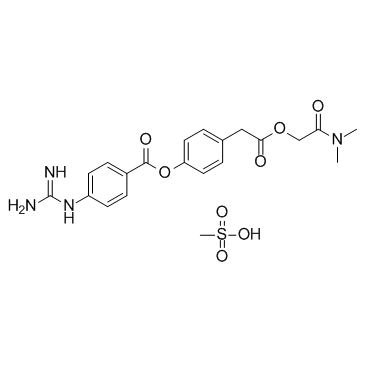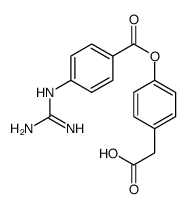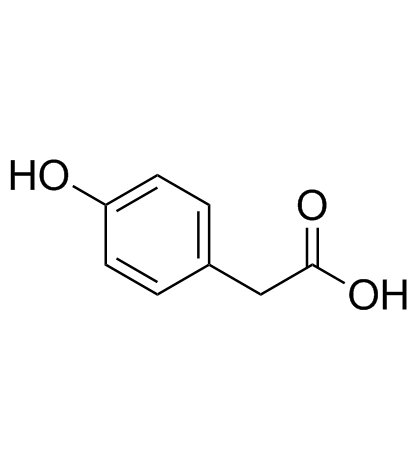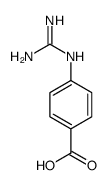59721-29-8
| Name | Camostat Mesylate |
|---|---|
| Synonyms |
Benzeneacetic acid, 4-[[4-[(aminoiminomethyl)amino]benzoyl]oxy]-, 2-(dimethylamino)-2-oxoethyl ester, methanesulfonate (1:1)
Camostat Mesylate [4-[2-[2-(dimethylamino)-2-oxoethoxy]-2-oxoethyl]phenyl] 4-(diaminomethylideneamino)benzoate,methanesulfonic acid 4-{2-[2-(Dimethylamino)-2-oxoethoxy]-2-oxoethyl}phenyl 4-carbamimidamidobenzoate methanesulfonate (1:1) MFCD00941410 Camostat mesilate Camostat (mesylate) |
| Description | Camostat Mesylate(FOY305; FOY-S980) is a trypsin-like protease inhibitorTarget: Trypsin-like proteaseCamostat mesilate (500 mM) inhibits generation of TGF-beta by suppressing plasmin activity and reduces the activity of TGF-beta, which blocks in vitro activation of HSCs [1]. Camostat mesilate (20 mM) combined with insulin results a significant hypoglycemic effect following large intestinal administration. Camostat mesilate (20 mM) is effective in reducing insulin degradation in both small and large intestinal homogenates of rats [2]. Camostat mesilate (2 mM) inhibits MCP-1 and TNF- production in activated rat monocytes. Camostat mesilate (2 mM) inhibits proliferation and MCP-1 production of cultured rat PSCs. Camostat mesilate (1 mg/g) prevents pancreatic atrophy and improves pancreatic exocrine function of rat chronic pancreatitis induced by DBTC. Camostat mesilate (1 mg/g) inhibits chronic inflammation and pancreatic fibrosis induced by DBTC. Camostat mesilate (1 mg/g) inhibits the development of pancreatic fibrosis and PSCs activation in the pancreas induced by DBTC. Camostat mesilate (1 mg/g) suppresses monocytes infiltration and inhibits MCP-1 expression both in serum and in pancreatic tissue [3]. |
|---|---|
| Related Catalog | |
| References |
| Boiling Point | 634.6ºC at 760 mmHg |
|---|---|
| Melting Point | 150-1550C |
| Molecular Formula | C21H26N4O8S |
| Molecular Weight | 494.518 |
| Exact Mass | 494.147125 |
| PSA | 197.56000 |
| LogP | 2.84290 |
| Storage condition | Desiccate at RT |
CHEMICAL IDENTIFICATION
HEALTH HAZARD DATAACUTE TOXICITY DATA
|
| Symbol |


GHS07, GHS09 |
|---|---|
| Signal Word | Warning |
| Hazard Statements | H315-H319-H335-H400 |
| Precautionary Statements | P261-P273-P305 + P351 + P338 |
| Hazard Codes | Xi,N |
| Risk Phrases | R36/37/38:Irritating to eyes, respiratory system and skin . |
| Safety Phrases | S26-S36 |
| RIDADR | UN 3077 9 / PGIII |
| RTECS | UV7720000 |
|
~% 
59721-29-8 |
| Literature: US4021472 A1, ; |
| Precursor 1 | |
|---|---|
| DownStream 4 | |




